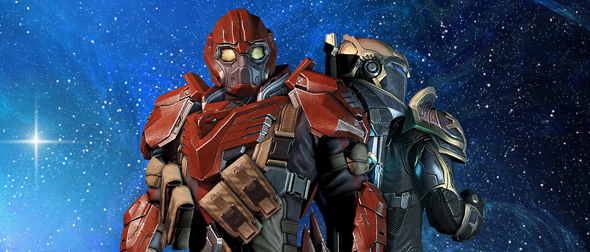Our Verdict
A brilliant resurrection of a classic. Speed and skill-driven mechanics separate Tribes from other modern shooters.
PC Gamer's got your back
Wonderful, breath-clutching games of chicken happen along the z-axis in Tribes: Ascend. You're hovering, the guy you want to kill is hovering, and you each have a few sips of battery juice left in your jetpack. Gravity is death: drop first, and you become an instant candidate for one of Tribes' splash-damage weapons: a grenade, Spinfusor disc, or gamma-ray-green mortar shell.
In these shared seconds of airtime, your brain crunches weapon trajectory paths, shot velocity, topography and damage radii—and there's a layer of deception happening atop that. Maybe I'll feint a fall, then right-click to lift at the last second. Maybe he'll whip out his secondary weapon to harass me out of the air with pistol shots. Maybe I'll put a grenade under him to force him to spend all his flight energy.
This is a lot of good nuance. Plenty of FPS games demand finesse, but Tribes: Ascend is one of the few I've played that supports this brand of mental-physical ballet (Quake III is another). In open beta since February, it still isn't without issues. Teamwork is suspiciously inconsistent, VOIP is absent, dedicated server support is slowly making its way in, some weapons have a high learning curve, vehicles don't influence matches as much as I wish they did.
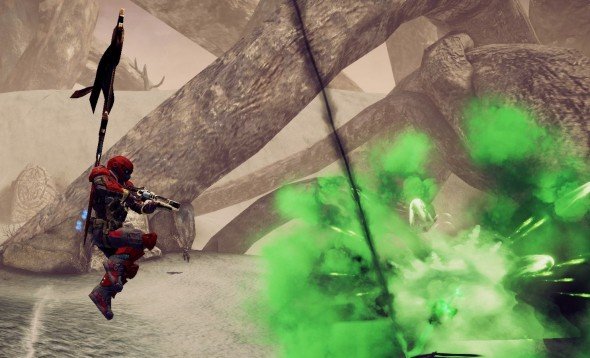
But mostly, it's a minor miracle that a young, independent studio has preserved so much of what made Tribes (Tribes 2, moreso) special, while turning it into a pretty affordable microtransaction-supported game in a new engine.
If high speed movement is your only point of reference for Tribes, know that it's as easy as it has ever been. Skiing is simple: hit the spacebar when you're facing down a hill, and you'll slide frictionlessly. It's like having bowling balls for feet. You maintain any momentum until you reach an upward slope, then right-click to jetpack up another hill.
That seesaw repetition between your thumb and the right mouse button is simple work. The hard and satisfying part comes in orienting yourself in the air to a trajectory that lets you land gently and without losing any momentum. Hi-Rez's smart addition of a speedometer to Tribes provides welcome feedback. If I flub a landing, I can see the dent it makes in my velocity immediately.
Après ski
For learning the basics, however, I wish Ascend's skiing tutorial was built in a way that provided real moment-to-moment feedback. The lone walkthrough talks you through it, but there's no dynamic, evaluative system in place to tell you if you should've jetpacked a half-second earlier or landed a bit more to the left of where you did. Right now, your best tutor is probably YouTube or loading a local server to drill by yourself or (when dedicated servers are available) with an experienced friend.
Overall, though, I admire the way Hi-Rez hasn't allowed Tribes' free to play accessibility to translate into dumbed-down mechanics; it's a damn pleasure to play an FPS that reveres movement again. The entry point for skiing is relatively low for anyone who plays shooters, but the skill ceiling is appropriately high. Masters of fast-movement throw explosives at their own feet to achieve max momentum. Expert flag-runners drill to find good routes. It all lends Tribes an aspirational quality I love: when you see someone moving fluidly, you want to get better.
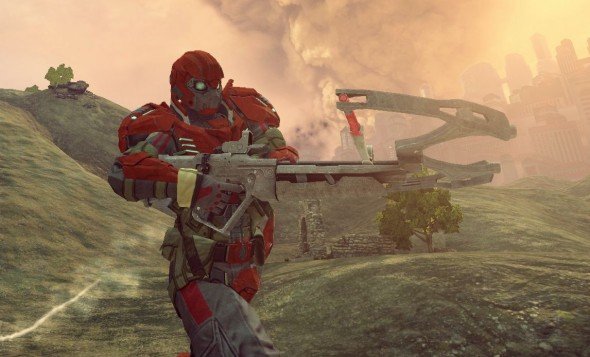
Movement isn't the only fun thing to do on Tribes' busty topography, thank goodness. Ascend is the first time Tribes has had classes, and I don't think their addition hampers the joy of finding a job on the battlefield and making it yours.
Sometimes I dedicate an entire round just to bringing down the enemy's generator (there's a stat in your profile that tracks generators killed per hour, my new favorite measurement), which powers their turrets, inventory stations and sensors. Even if I die, I'm happy knowing I held the attention of three or four enemies in the process.
Sometimes I focus on taking speed away from enemies in the midfield—filling skiing lines with chaingun munition and throwing flag-runners off their stride. A more direct—and totally viable—job is playing a Juggernaut with the Super Heavy perk, standing right on the flag to block banner thieves. It's wonderful that players who don't want to be athletic still have a dozen ways to be heroes. And that I can migrate between these positions depending on map and mood.
With role variety as a strength, though, it's puzzling that Tribes' incentives for teamwork are so thin. Kill assists and flag passing are the only game mechanics in place that directly encourage players to work together. It's frustrating when a public match devolves into a bunch of individuals doing their own thing. It happens much more than I'd like, and I don't think it's simply the fault of players.
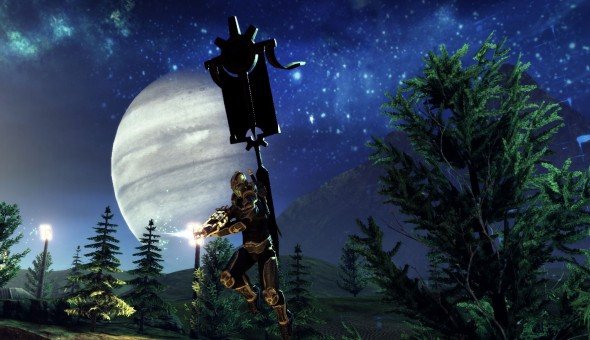
Radio silence
Tribes' teamwork-sapper is the absence of voice communication. This is its most serious flaw. The voice hotkey system that exists in its place is as efficient as something of its kind can be: it abbreviates your input for common phrases (tap “VDG” to broadcast “Defend our generator!”; “VSRB” for “I'll repair our base”) but provides no room for real strategic planning. When all players are drawing from the same pool of voice files, too, it gives your teammates this facelessness that lessens your connection to them. Every once in awhile, it'll feel like you're playing with parrots, especially if a teammate spams random chatter ("Shazbot!" "Shazbot!" "Shazbot!" isn't uncommon) to drown out other allies' good commands.
The irregularity of teamwork has made me start favoring Tribes' team deathmatch mode, which operates really well as a break from the responsibility of base-guarding. It's more mindless than CTF: a swirling hive of players spend lives from a shared pool of a hundred per team, chasing a single flag (owning it makes your team's kills worth double). I like the circular shape of these maps—a NASCAR-like train of players tends to form behind the flag carrier, jousting and trading fire. It's a great sight.
Hi-Rez's other mode experiments are a five-on-five TDM arena mode and a “capture and hold” point control mode. The former bores and frustrates me compared to CTF; arena's maps are flat, rigid ledges floating in the sky that make skiing impractical. But I like the way capture and hold gets players out of their comfort zones and makes different tactics more viable than in CTF. I tried rolling Juggernaut, a class I never play, to flood capture points with mortar rounds, and was rewarded with a game-leading 41 kills. That experience made mortaring more attractive to me, and I'm more likely now to give heavy classes a shot in CTF and other modes.
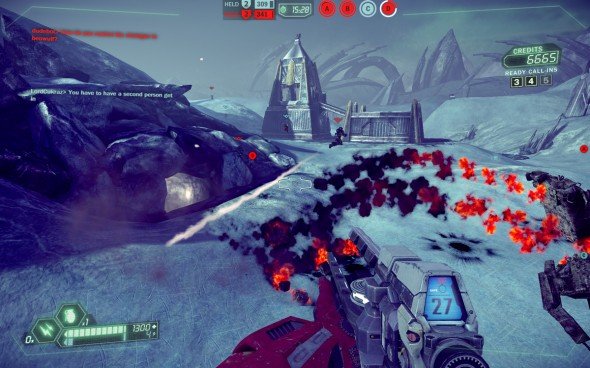
Cost of living
Tribes' free-to-play model is pretty fair, as those things go. Pricing is tiered: spending more gets you proportionately more in-game currency. For $50, you get 5,500 gold, or 110 gold/dollar. For $20, you get 1,800 gold, or 90 gold/dollar. $30 (3,000 gold) is enough to try every class and specialize in two or three. The six paid classes (everyone gets the Pathfinder, Soldier, and Juggernaut free) cost between 160 and 280 gold each. All six is 1,360 gold, or about $13.
That's reasonable—the barrier to finding your favorite class is low. Owning more classes opens more gateways to player purchasing of weapons, perks, skins and equipment, most of which cost more. The most expensive weapons are about $8, and that does include attractive guns such as the MIRV (a cluster-mortar that fires a shell that splits in mid-air) and the Infiltrator's Jackal, the only remote detonation weapon in Tribes. The two currently-available skins are $6.75 and $9.75—high, but comparable to cosmetic equivalents in League of Legends, for example.
Paid (“VIP”) players are awarded bonus XP after each match, but skill still absolutely overrides those boons. At the time of writing, all weapons and perks can also be purchased with that freely earned XP. Most importantly, the payment model doesn't replace the need to master Tribes' weapons and movement. You still have to aim where enemies will be, not where they are.
The great feedback the guns give facilitates this. Nearly all project their firing path and velocity, either with a tracer or a colored comet tail. Admiring a shot in the air that you know will connect with an enemy's face is one of Tribes' unique joys.
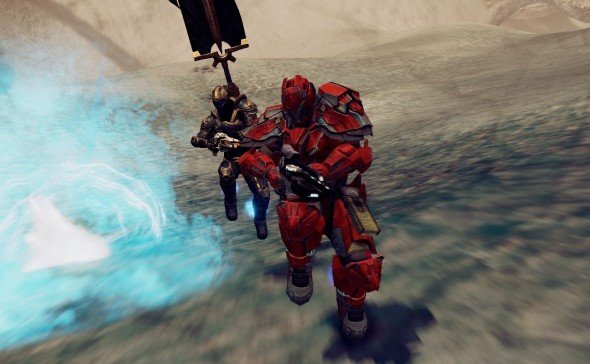
My gripes don't end with the sparse teamwork, however. Base interiors are simplistic. The menu UI feels a little bulky and nested. I also don't like how ancillary vehicles are to victory; they're an expensive way of attracting attention to yourself and getting killed. The most useful—an air fighter called the Shrike—is a pricey, hard-to-handle mosquito in the hands of anyone other than a pro pilot.
Little of this, however, gets in the way of the primal, potent feelings of chasing and being chased. There's a thing that happens often in the middle of most maps: you pass a foe at high speed en route to each other's base. Usually you're going too fast to even bother attacking—you both silently tip your hats and hope the other guy gets killed by your team. One time I blazed past a light-armored player in the center like this. My brain took over, reflexively telling my hand to left-click. I flicked a Spinfusor disc over my shoulder. Through no will of my own, it connected. He died, and I slid on unmolested, yelling only the word “WHAT” over and over at my monitor.
This Venn overlap of intuition and speed is where Tribes' magic takes place: it produces hair-raising hole-in-one shots in a way that no other modern FPS can match.
A brilliant resurrection of a classic. Speed and skill-driven mechanics separate Tribes from other modern shooters.

Evan's a hardcore FPS enthusiast who joined PC Gamer in 2008. After an era spent publishing reviews, news, and cover features, he now oversees editorial operations for PC Gamer worldwide, including setting policy, training, and editing stories written by the wider team. His most-played FPSes are CS:GO, Team Fortress 2, Team Fortress Classic, Rainbow Six Siege, and Arma 2. His first multiplayer FPS was Quake 2, played on serial LAN in his uncle's basement, the ideal conditions for instilling a lifelong fondness for fragging. Evan also leads production of the PC Gaming Show, the annual E3 showcase event dedicated to PC gaming.
